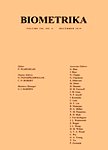-
作者:Jansen, Maarten
作者单位:Universite Libre de Bruxelles
摘要:The optimization of an information criterion in a variable selection procedure leads to an additional bias, which can be substantial for sparse, high-dimensional data. One can compensate for the bias by applying shrinkage while estimating within the selected models. This paper presents modified information criteria for use in variable selection and estimation without shrinkage. The analysis motivating the modified criteria follows two routes. The first, which we explore for signal-plus-noise o...
-
作者:Fan, Yingying; Lv, Jinchi
作者单位:University of Southern California
摘要:Two important goals of high-dimensional modelling are prediction and variable selection. In this article, we consider regularization with combined L-1 and concave penalties, and study the sampling properties of the global optimum of the suggested method in ultrahigh-dimensional settings. The L-1 penalty provides the minimum regularization needed for removing noise variables in order to achieve oracle prediction risk, while a concave penalty imposes additional regularization to control model sp...
-
作者:Zou, Changliang; Peng, Liuhua; Feng, Long; Wang, Zhaojun
作者单位:Nankai University
摘要:This article concerns tests for sphericity in cases where the data dimension is larger than the sample size. The existing multivariate sign-based procedure (Hallin & Paindaveine, 2006) for sphericity is not robust with respect to high dimensionality, producing tests with Type I error rates that are much larger than the nominal levels. This is mainly due to bias from estimating the location parameter. We develop a correction that makes the existing test statistic robust with respect to high dim...
-
作者:Liu, Jingchen; Gelman, Andrew; Hill, Jennifer; Su, Yu-Sung; Kropko, Jonathan
作者单位:Columbia University; New York University; Tsinghua University
摘要:Iterative imputation, in which variables are imputed one at a time conditional on all the others, is a popular technique that can be convenient and flexible, as it replaces a potentially difficult multivariate modelling problem with relatively simple univariate regressions. In this paper, we begin to characterize the stationary distributions of iterative imputations and their statistical properties, accounting for the conditional models being iteratively estimated from data rather than being p...
-
作者:Kraus, Andrea; Panaretos, Victor M.
作者单位:Swiss Federal Institutes of Technology Domain; Ecole Polytechnique Federale de Lausanne
摘要:We consider the problem of inferring the potential of an epidemic for escalating into a pandemic on the basis of limited observations in its initial stages. Classical results of Becker & Hasofer (J. R. Statist. Soc. B, 59, 415-29) illustrate that frequentist estimation of the complete set of parameters of an epidemic modelled as a birth and death process remains feasible even when one is able to observe only the deaths and the total number of births. These assumptions on the observation mechan...
-
作者:Peters, J.; Buehlmann, P.
作者单位:Swiss Federal Institutes of Technology Domain; ETH Zurich
摘要:We consider structural equation models in which variables can be written as a function of their parents and noise terms, which are assumed to be jointly independent. Corresponding to each structural equation model is a directed acyclic graph describing the relationships between the variables. In Gaussian structural equation models with linear functions, the graph can be identified from the joint distribution only up to Markov equivalence classes, assuming faithfulness. In this work, we prove f...
-
作者:Fonseca, T. C. O.; Ferreira, M. A. R.; Migon, H. S.
-
作者:Vogt, Michael; Linton, Oliver
作者单位:University of Cambridge
摘要:We investigate a nonparametric regression model including a periodic component, a smooth trend function, and a stochastic error term. We propose a procedure to estimate the unknown period and the function values of the periodic component as well as the nonparametric trend function. The theoretical part of the paper establishes the asymptotic properties of our estimators. In particular, we show that our estimator of the period is consistent. In addition, we derive the convergence rates and the ...


